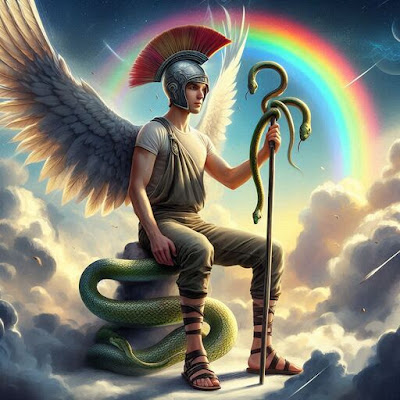The Legend of Hermes: Messenger of the Gods and Patron of Boundaries
Hermes, the ancient Greek god of trade, thieves, travelers, and sports, also served as the messenger of the gods. Known for his cunning and cleverness, Hermes is a versatile deity with roles that extend to guiding souls to the underworld. His ability to move swiftly between the divine and mortal worlds, his inventiveness, and his playful nature make Hermes a distinctive figure in Greek mythology.
Origins and Birth
Hermes was born in a cave on Mount Cyllene in Arcadia, the son of Zeus and the Pleiad Maia, a nymph. According to legend, he was a precocious infant who, on the day of his birth, invented the lyre from a tortoise shell and stole Apollo's cattle, cleverly reversing their hooves to confuse their tracks. This myth highlights his attributes of inventiveness and cunning from a very young age.
Attributes and Symbols
Hermes is often depicted wearing winged sandals (talaria) and a winged hat (petasos), carrying a caduceus, a staff entwined with two serpents. This symbol, often confused with the rod of Asclepius (a single serpent entwined rod associated with medicine), became a symbol of commerce and negotiation. Other common attributes include the rooster and the tortoise, animals connected to his birth myth.
Roles and Responsibilities
As the messenger of the gods, Hermes's primary role was to convey messages and conduct divine tasks on behalf of Zeus and the other Olympian gods. His speed and agility were unmatched, allowing him to move freely and quickly between the heavenly and earthly realms.
Hermes also served as a guide for souls heading to the underworld, showing his softer and more guiding nature. His role extended to being the god of boundaries and the travelers who cross them, which included protecting and taking care of herdsmen, merchants, and thieves, as well as overseeing roads and commerce.
Myths Involving Hermes
One of the most famous myths involving Hermes is his intervention to save Odysseus from the enchantress Circe in Homer's "Odyssey." Hermes provides Odysseus with the magical herb moly, making him resistant to Circe's magic. This demonstrates his role as a protector and helper of mankind, bridging the gap between mortals and gods.
Hermes's relationship with Apollo, initially strained due to Hermes stealing his cattle, is quickly mended by the gift of the lyre. This act turned Hermes from a trickster into an important cultural figure, symbolizing reconciliation and exchange between gods.
Cult and Worship
Hermes was widely worshipped throughout Greece, with festivals such as the Hermaea celebrating his association with athletics and youthful endeavors. Pillars called herms, featuring the head of Hermes and phallic symbols, were used as road and boundary markers, protecting travelers and signifying his role as a protector of boundaries and those who cross them.
Legacy and Cultural Influence
In literature and art, Hermes is portrayed as witty, playful, and cunning but also as a bringer of good fortune and wealth. His character has been adapted into various literary and cultural works, embodying the archetype of the trickster in narratives worldwide.
Conclusion
Hermes's enduring appeal lies in his multifaceted roles as a messenger, protector, trickster, and guide. He embodies the qualities of adaptability, eloquence, and movement, reflecting the dynamic nature of human interaction with the world. His legends provide valuable insights into the ancient Greek understanding of commerce, communication, and the supernatural, making Hermes a key figure in mythology and a protector of human activities.

Comments
Post a Comment